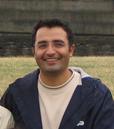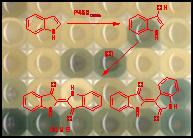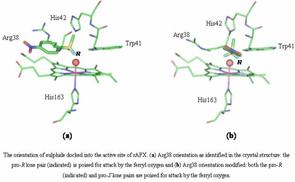
Ayhan Celik graduated from the Blacksea Technical University, Trabzon, Turkey, in 1993 with his B.A. degree in Chemistry with Education. Then he received M.Sc. in Analytical Science at the University of Hull, UK.,in 1997, under the supervision of Professor Alan Townshend. He was awarded his Ph.D. degree in 2001 for a thesis on ’ÄúUtilizing Haem Enzymes in Catalytic Oxidation Chemistry’Äù, under the supervision of Professor Paul M. Cullis and Dr. Emma L. Raven at the University of Leicester. A subsequent Research Assistant/Associate at the University of Edinburgh involved the application of cytochrome P450 enzymes in fine chemical synthesis with Professor Nick J Turner and Professor Sabine L. Flitsch. In 2005, he joined the Professor Davis Group, University of Oxford, where he is currently working on Biocatalytic CO2 sequestering and conversion into various potentially valued chemicals.
His interest includes Cloning, Protein Engineering, Enzyme structure/function relationship, Biocatalysis, Biotransformation, High Throughput Screening (HTS), Enzyme kinetics, Immobilization, Novel assay developments. Some aspects of his work have been highlighted below.
One of the most challenging reactions in contemporary organic synthesis is the selective hydroxylation of unactivated C-H bonds. This transformation has considerable potential in the efficient synthesis of fine chemicals as well as pharmaceutical and agrochemical intermediates. Unfortunately, there are few chemical methods available for the selective hydroxylation of a target compound. Biological systems, on the other hand, are well suited to such transformations. In particular, cytochrome P450 monooxygenases have been found to mediate these reactions including associated hetereoatom oxidation of organic substrates. We have shown that many P450s are well suited for such reactions including (a) P450 BM3 for enantioselective sulphoxidation of alkyl aryl sulphide and regio and enantioselective epoxidation of unsaturated fatty acids), (b) P450 SOY, SU1, SU2 for regio- and enantio-selective terpene hydroxylation) and more recently P450RhF for dealkylation.

The work also involves in developing micro scale, high-throughput and fast-running methods for screening either a substrate library or/and a mutant library generated by either site-directed mutagenesis or directed evolution. For example, high-throughput screening of cytochrome P450CAM libraries for their ability to oxidize indole to indigo (blue in color) and indirubin, has resulted in the identification of variants with activity towards the structurally unrelated substrate diphenylmethane.

The ability to design enzymes that are able to carry out specific chemical transformations is one of the long-term goals of the biotechnology industry. The environmental benefits associated with biocatalytic approaches of this kind have particular commercial appeal. Catalytic oxidation of aromatic molecules by haem peroxidases has attracted much commercial interest, and the ability to use peroxidase enzymes for enantioselective oxidations of aromatic thiols is also a realistic target. We are interested in ascorbate peroxidase (APX), a member of the haem peroxidase family, is able to catalyse the oxidation of a range of high valued substrates and that the enzyme can be rationally redesigned to incorporate new enantioselective reactivities.

- ˆáelik, Ayhan., Cullis, P.M., Lloyd Raven, E. ’ÄúCatalytic Oxidation of p-Cresol by Ascorbate Peroxidase’Äù Arch. Biochem. Biophy (2000), 373,175
- ˆáelik Ayhan; Cullis P.M.; Sutcliffe M.J.; Sangar R.; Raven E.L. ’ÄúEngineering the Active site of Ascorbate Peroxidase’Äù European J. Biochemistry (2001), 268 (1), 78
- Raven E. L; ˆáelik, Ayhan; Cullis, P.M; Sangar, R and. Sutcliffe, M. J. Biochem. Soc. Trans, (2001), 29, 105
- Roberts, GA., ˆáelik, Ayhan. et al.. ’ÄúA self-sufficient cytochrome P450 with a primary structuralorganisation that includes a flavin domain and a [2Fe2S] redox center’Äù J.Biol.Chem. (2003), 278, 48914
- ˆáelik, Ayhan; Speight, Robert E and. Turner, Nicholas J. ’ÄúIdentification of broad specificity P450CAM variants by primary screening against indole as substrate’Äù, ChemComm.(2005), 29, 3652. (Featured in Chemistry World, September 2005, issue:2,)
- ˆáelik, Ayhan; Sperandio, Davide; Speight Robert E and. Turner, Nicholas J. ’ÄúEnantioselective epoxidation of Linolenic acid catalysed by Cytochrome P450 BM3’Äù Organic and Biomolecular Chemistry, (2005), 3 (15), 2688
- ˆáelik, Ayhan, Flitsch, Sabine L. and Turner, Nicholas J. ’ÄúEfficient terpene hydroxylating biocatalyst derived from Actinomycetes’Äù, Organic and Biomolecular Chemistry, (2005) 16,2930-2934
- ˆáelik, Ayhan; G.A. Roberts; J.H. White; S.K. Chapman; N.J. Turner ve S. L. Flitsch ’ÄúProbing the substrate specificity of the catalytically self-sufficient cytochrome P450 RhF from a Rhodococcus sp.’Äù ChemComm (2006), 43, 4492-4494
Last updated: 30-04-07
Prof Ben G. Davis
University of Oxford
Chemistry Research Laboratory
Mansfield Road
Oxford, OX1 3TA, UK
Phone: + 44 (0)1865 275652
Fax: + 44 (0)1865 275674
Ben.Davis@chem.ox.ac.uk
